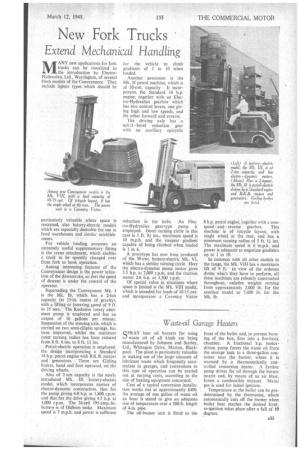• New Fork Trucks
Page 51

If you've noticed an error in this article please click here to report it so we can fix it.
Extend Mechanical Handling
MANY new applications for fork trucks can be visualized in the introduction by ElectroHydra ulics, Ltd., Warrington, of several fresh models of the Conveyancer. They include lighter types which should be
particularly valuable where space is restricted, also battery-electric models which are especially desirable for use in food warehouses and similar establishments.
For vehicle loading purposes an extremely useful supplementary fitting is the crane attachment, which enables a truck to be speedily changed over from fork to hook operation. .
Among interesting features of the Conveyancer design is the power actuation of the downstroke, so that the speed of descent is under the control of the operator.
Superseding the Conveyancer Mk. I is the Mk. lb, which, has a 2-ton capacity (at 15-in, centre of gravity), with a lifting or lowering speed of 9 ft. in 15 secs. The Keelative rotary abutment pump is employed and has an output of 10 gallons per minute. Suspension of the steering axle, which is carried on two semi-elliptic springs, has been improved, whilst the minimum outer turning radius has been reduced from 8 ft. 6 ins. to 6 ft. 11 ins.
-Petrol-electric operation is employed, the design incorporating a Standard 14 h.p. petrol engine with B.K.B. motors and generators. There are Girling brakes, hand and foot operated, on the driving wheels.
Also of 2-ton capacity is the newly introduced Mk. III battery-electric model, which incorporates motors of electro-dynamic construction, that for the pump giving 6.8 h.p. at 1,800 r.p.m. and that for the drive giving 4.5 h.p. at 1,000 r.p.m. The 36-cell 195-amp.-hr. battery is of Oldham make. Maximum speed is 7 m.p.h. and power is sufficient for the vehicle to climb gradients of 1 in 10 when loaded.
Another newcomer is the Mk. II petrol machine, which is
of 30-cwt. capacity It incorporates the Standard 14 h.p. engine, together with an Electro-Hydraulics gearbox which has two control levers, one giving high and low speeds, and the other forward and reverse.
The driving axle has ,a. spir.11bevel reduction gear with an auxiliary epicyclic reduction in the hubs. An Electro-Hydraulics gear-type pump is employed. Outer turning circle in this case is 5 ft. 91ins., maximum speed is 10 m.p.h. and the steepest gradient capable of being climbed when loaded is 1 in 6.
A prototype has now been produced of the 30-cwt. battery-electric Mk. VI, which has a similar turning circle. Here the electro-dynamic pump motor gives 3.5 h.p. at 2,000 r.p.m. and the traction motor 2.6 h.p. at 1,500 r.p.m.
Of special value in situations where space is limited is the Mk. VIII model, which is intended for loads of 10-15 cwt. and incorporates a Coventry Victor 8 h.p. petrol engine, together with a two-,
speed and reverse gearbox, This machine is of tricycle layout, with single wheel at the rear, and has a minimum turning radius of 5 ft. lf ins. The maximum speed is 6 -m.p.h. and power is adequate to negotiate gradients up to 1 in 10.
In cormnon with all other models in the range.,"the Mk. VHI has a maximum lift of 9 ft. In view of the arduous duties which they have to perform, all these machines are robustly constructed throughout, unladen weights varying from approximately 3,000 lb. for the smallest model to 7,400 lb. for the Mk. lb.


















































































